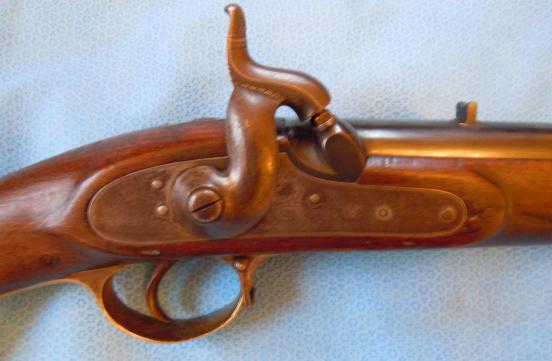Good Pattern 1844 Yeomanry Cavalry Carbine
This is a very good P-1844 Yeomanry Cavalry Carbine.
The P-1844 Yeomanry Carbine was adopted as a somewhat smaller and lighter variation of the P-1843 Second Pattern Victoria Carbine. Both guns utilized a P-1842 percussion lock, designed by George Lovell who was appointed the Small Arms Inspector at the Royal Small Arms Factory at Enfield Lock (RSAF) in 1840. Lovell was a very forward thinking and modern armorer, and strove for uniformity in production, high levels of quality control and sought to produce the most modern and perfected percussion weapons in the world. Lovells influence on British military small arms from the late 1830s through his tenure as Small Arms Inspector had a major influence on British military small arms design and production.
The M-1844 Yeomanry Carbine had a 20 smooth bore barrel that was nominally .66 caliber, a reduction from the Victoria Carbines .73 caliber bore. The smaller caliber was more in line with the traditional English carbine bore of .65 caliber. The barrel was secured to the stock by a screw through the tang of the breech and a pair of barrel wedges, of the same design that Lovell had introduced for the P-1842 musket, which replaced the pin barrel designs that the British military had utilized since the late 1600s. The gun had a simple fixed post rear sight; a captive swivel ramrod and a single brass rammer pipe to help keep the ramrod secured when not in use. The butt plate and trigger guard were also of brass. The trigger guard had a skeletonised pistol grip extension to its rear, similar to that of the Brunswick rifle trigger guard, and the forward bow sported a single sling swivel. A sling bar of about 7 in length was mounted to the left side of the carbine
This carbine is in very good to fine condition with a crisp lock, plethora of proof and view marks and has the letter RMLYC engraved on the butt plate which I am told explains it was issued to the Royal Midlothian Yeomanry Cavalry. Metalwork is excellent and the woodwork is sound, altogether a very pleasing example and becoming scarcer. One comment I would make is that there are six uniform scratch or "tally" marks near the foresight which clearly were put there deliberately. Were these to indicate battle success. I doubt if you would take the trouble to do this shooting rabbits!
Feel free to ask any questions or for additional images to serious enquirers.
Code: 50129





